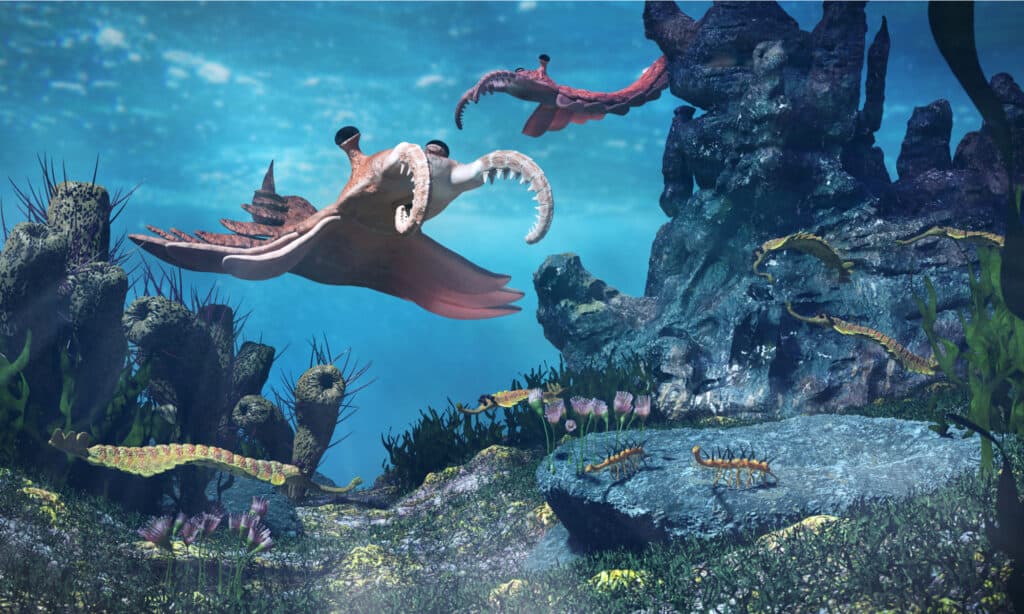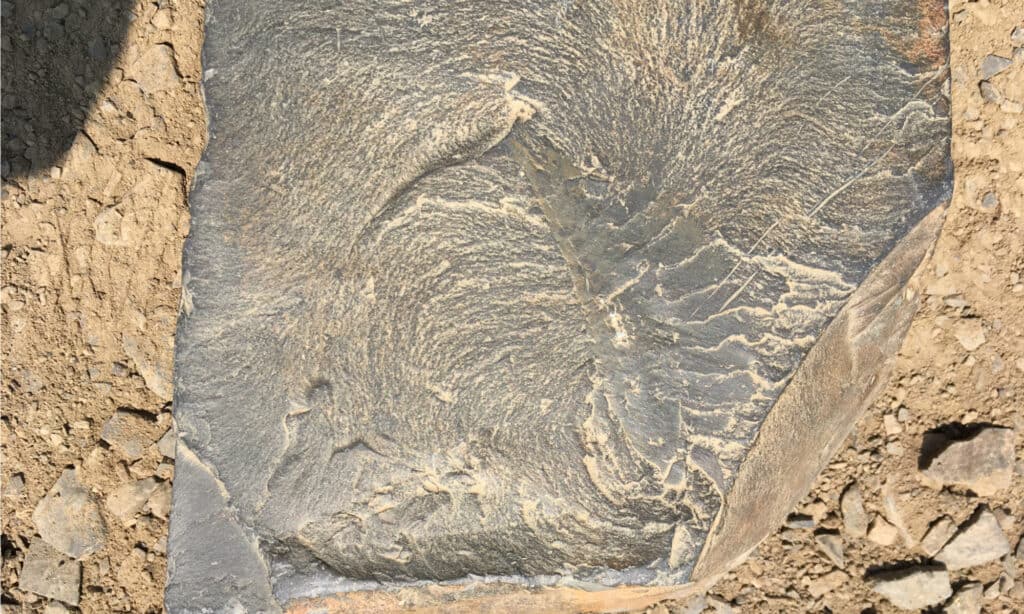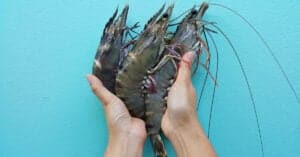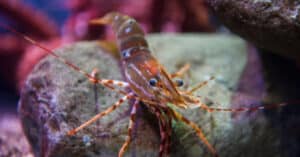This animal belongs to the category of evolution’s apex predators. It existed at the start of the evolution of life on earth, about 500 million years ago. Many weird creatures evolved during this period, called the Cambrian period.
Anomalocaris is an animal that evolved about half a billion years back. It evolved when life on earth was limited to marine life. The vast oceans homed various bizarre creatures of which Anomalocaris was an apex predator. It looked like a shrimp but in a much bigger size.
Anomalocaris shares similar features with arthropods and is classified as a stem-group arthropod. This article will discuss what the Anomalocaris looked like, when it existed and how it went extinct. We will also discuss how this strange creature lived in the seas millions of years ago.
Description & Size
Anomalocaris means ‘unlike shrimp/crab’ from the Greek words ‘anomoios’ and Latin word ‘saris,’ respectively. This animal was like a giant shrimp possessing long appendages on its head. It was an invertebrate flat from both the upper and lower surfaces. It had a tail fan with three-pair fins extended upwards. Anomalocaris had a segmented body that ended with this tail fin.
They had large protruding eyes with two lengthened appendages on their head. The appendages each had 14 segments. They also had sharp spikes protruding from the appendages. On their body, they had over eleven laterally positioned flaps for swimming. Some features of the Anomalocaris include:
- Length – up to 1.25 feet, and larger species can grow up to 3 feet
- Weight – about 20 lb
- Attributes – Shaped like a shrimp, flattened body, a nonvertebrate, large protruding eyes.
- Genus – Anomalocaris
Anomalocaris belongs to the Anomalocarididae family. It is described as a distant arthropod relative. It used the flexible flaps on its body to swim and hunt. Its identified species are
- Anomalocaris canadensis
- Anomalocaris briggsi
- Anomalocaris kunmingensis
- Anomalocaris magnabasis
- Anomalocaris pennsylvanica
- Anomalocaris saron
This animal is neither a shrimp nor an ancient relative of today’s shrimps. Anomalocaris was misidentified as a sea sponge in the early 1900s. Fossil discoveries in the 1980s revealed consistent body parts. These body parts exposed what a weird-looking creature the Anomalocaris was.
The mouth of an Anomalocaris had 32 intersecting plates which could crush its prey. Some bite marks on trilobites have become evident to the Anomalocaris’ biting ability. However, the lack of wear and tear on the plates puts a hole in its biting ability hypothesis. It had about thirty thousand lenses in its eyes, which means it had compound eyes.

©Dotted Yeti/Shutterstock.com
Diet – What Did Anomalocaris Eat?
Anomalocaris was a carnivorous animal, as earlier stated it was described as an apex predator of its time. As evolution’s first known apex predator, this animal hunted and preyed on other organisms in the water. It also hunted shelled animals like trilobites. Evidence also suggests that some Anomalocaris species were likely filter feeders.
This animal would force its prey through its mouth to kill it. It preyed on other arthropods and could crush tough animals with its mouth. They also fed on worms and other soft animals.
They had short and strong spines which could have worked as arms for grabbing prey. The spines could have helped grab trilobites and crush their shells to suck their innards. Its flat, streamlined body also allowed it more flexibility for hunting and catching prey.
Habitat – When and Where Anomalocaris Lived
Anomalocaris evolved during the early Cambrian period. The Cambrian period was the first period of the Paleozoic era. This era can also be described as the beginning of the evolution of life on earth. Anomalocaris lived about 505 million years ago.
Anomalocaris was a marine animal as it existed during a period when the evolution of life was restricted to the vast waters. It populated the waters and dominated the locations it lived. Their presence in China, Canada, the United States of America, and Australia suggest that they were present across the globe.
Threats and Predators
Anomalocaris was a giant creature for its time. It means they likely had no rival in the waters. They are described as the top predators of their time and they likely had no predators. They were efficient hunters, but due to the size and shape of their mouths, they likely couldn’t hunt animals as big as their size.
This animal ruled the seas in its time and hardly had a rival. However, the environment that gives life is also an organism’s greatest threat. It was also true for the Anomalocaris as it did not survive the Great Permian Extinction.
Discoveries and Fossils – Where Anomalocaris Was Found
Anomalocaris was unearthed in 1892 when scientists only identified the appendages. Parts of its mouth were later discovered in 1911. These discoveries made it mistaken for a jellyfish, and it was given the name Peytoia.
An Anomalocaris’ body was later discovered, which was mistaken for a sea sponge and named Laggania. By the 1980s, the fossil discoveries had been compared, and it was discovered that they belonged to the same creature, the bizarre Anomalocaris.
It has been speculated that this animal was distributed worldwide due to its presence on various continents. Anomalocaris’ fossils have been found in Greenland, the Burgess Shale of Canada, Australia, Utah, and China.

©Gavin Howard/Shutterstock.com
Extinction – When Did Anomalocaris Die Out?
Anomalocaris went extinct as the Cambrian period came to an end. A mass extinction occurred at the end of this period called the Great Permian Extinction. This extinction was one of the first and most significant extinction events.
The Great Permian Extinction wiped out about 90% of earth’s life. This mass extinction was caused by extreme global warming. Marine life could not breathe, which led to these marine creatures’ mass death. Today’s arthropods like crabs and lobsters are distant relatives of Anomalocaris that evolved.
Similar Animals to Anomalocaris
Anomalocaris existed at the beginning of evolution as the apex predator. It is an invertebrate that looks like a shrimp and is distantly related to today’s arthropods like lobsters. There are about 6 known species of Anomalocaris, all of which have the shrimp look. Some similar animals to the Anomalocaris include:
Lobster
Lobsters are crustaceans and clawed invertebrates that belong to the notochord animal group. While not all have claws, clawed lobsters live in cold waters. The two types of lobsters are Spiny and Clawed lobsters. Spiny lobsters do not have claws. This crustacean prefers eating its prey alive and can grow over 3 feet long.
Crab
Crabs are crustaceans of the Decapoda order. They live in brackish, salty, or freshwater coastal locations. There are over 4500 known species of crabs around the globe. This crustacean is an omnivore meaning it feeds on plants and meat. They possess an exoskeleton that protects their soft body tissues underneath. The largest species of crab known is the Japanese Spider Crab, at up to 12 feet.
Trilobites
Trilobites are a group of extinct arthropods that can be segmented into three body parts. Trilobite in Latin means ‘three-part body.’ They were marine animals, and some dug into and around muddy water floors while others could swim. This animal group was the first to evolve complex eyes.
Flatworm
Flatworms are carnivorous invertebrates from the Phylum Platyhelminthes. There are about 20,000 known species around the world. They live in lakes, ponds, streams, freshwater, and their host. Flatworms can be parasitic, and the parasitic ones live in their host, which can be another animal or a human.
Jellyfish
Jellyfish is an invertebrate marine animal with about 90 to 95% water composition. This animal lives in oceans around the globe. This animal has respiratory composition and no brain, meaning no nervous system. They are famous for their ‘bell heads’ and dangling tentacles.
Conclusion
Anomalocaris is not a shrimp but a look-alike of one. It was mistaken for a shrimp and later a jellyfish on its initial discoveries. This ancient animal evolved at the beginning of evolution on earth. It existed as a top predator of its time and is famous as one of the earth’s first apex predators.
The photo featured at the top of this post is © Dotted Yeti/Shutterstock.com
FAQs (Frequently Asked Questions)
When was the Anomalocaris Alive?
Anomalocaris was alive about 505 million years ago during the Early Cambrian period. This period was the first period in the Paleozoic era, which started the earth’s evolution of life. They did not survive the mass extinction at the Cambrian period’s end, which killed up to 90% of earth’s life.
How Big was Anomalocaris?
Anomalocaris could grow up to 1.3 feet, with bigger species growing up to 3.3 feet. They could weigh about 20 lb. As apex predators of their time, they were giant creatures of the time.
Could Anomalocaris move on land?
Anomalocaris was a marine animal. It existed at a period in evolution when life was marine-based. There were vast seas and oceans during the Cambrian period. The large bodies of water helped Anomalocaris evolve different species and spread across the globe.
Was Anomalocaris a good hunter?
Anomalocaris was an apex predator of its time. It topped the food chain before more giant and fearsome creatures evolved. They are described as the earth’s first apex predators.
Thank you for reading! Have some feedback for us? Contact the AZ Animals editorial team.







